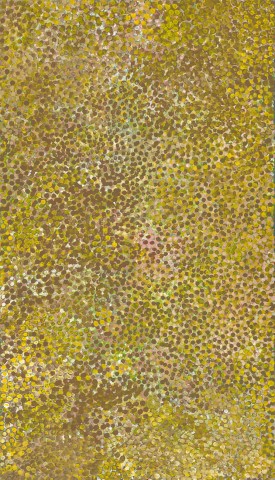A DESERT LIFE CYCLE III, 1991
EMILY KAME KNGWARREYE
synthetic polymer paint on linen
230.0 x 130.0 cm
bears inscription verso: artist’s name, Commissioned by Delmore Gallery, CHAPMAN and Delmore Gallery cat. 1S14
Commissioned by Delmore Gallery, via Alice Springs, Northern Territory
Chapman Gallery, Canberra
Private collection, Canberra
This work is accompanied by a certificate of authenticity from Delmore Gallery, via Alice Springs.
Undoubtedly one of Australia’s greatest painters of the twentieth century, Emily Kame Kngwarreye’s success came after a lifetime making art – initially in her role of ceremonial leader, painting the bodies of fellow Anmatjerre women for ceremony; subsequently as a prominent member of the Utopia Women’s batik movement and in the later years of her life, sustaining the unprecedented demand for her paintings following the successes of her early exhibitions.
Often a response to the everchanging landscape of her traditional homelands at Alhalker (Alalgura) close to Utopia, north east of Alice Springs, the paintings of country by Emily Kngwarreye record her acute observation, often in minute detail, of the shifting fluctuations in the state of the flora around her, alerting her to the readiness of bush food or medicinal plants. Painted in 1991, A Desert Life Cycle III celebrates the post-summer dryness, where a muted carpet of scattered seeds and grasses dot the landscape yet despite the dryness, underground tuber vegetables and certain berries are ripe for picking. Judith Ryan notes that, ‘clearly Emily Kngwarreye was a mark-maker extraordinaire…. she ventured further with masses of dots and marks, making intimate and grand gestures layering and intensifying the dots to the exclusion of graphic elements’1 and here the layers of white, olive, yellow, purple, and grey dots, in many places applied by the artist using her fingers, faithfully evoke the colours of her country. The black ground may be seen as the spread of the roots of Emily Kame Kngwarrere’s totemic yam plant underground, and the spread of ancestral forces through the earth.
The accompanying certificate notes that; ‘To look on Emily's work from an aerial perspective is necessary to understanding her view of her country. In a layered approach with colour, we see the sporadic clustered growth of plants in different stages of maturity. Knowledge about the life cycles of plants is learned in everyday situations and reinforced in ceremony. Ceremony asserts that the combined spiritual power of women assures fertility and future seasons for all desert life forms’.2
Although following in the wake of the success of Western Desert painting, Emily Kngwarreye became nationally and internationally recognised for the way in which her painting intuitively responded to her specific cultural experience. The many stylistic shifts she effortlessly adopted allowed her work to evolve, yet be constantly fresh.
1. Ryan, J. cited in Isaacs, J. et al., Emily Kngwarreye Paintings, Craftsman House, Sydney, 1998, p. 77
2. Taken from the accompanying certificate of authenticity from Delmore Gallery.
CRISPIN GUTTERIDGE
